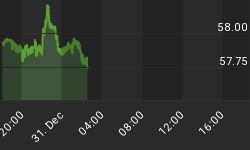We have noticed some fundamental differences between the governments of China and the U.S. First, the U.S. government owes the rest of the world almost $11 trillion. China has about $2 trillion of reserves built up over the years. The U.S. Secretary of State was in China this weekend begging for them to buy more U.S. debt. China was noncommittal. The U.S. government is trying to make everyone poorer though the Obama Pork Plan. China has raised hundreds of millions of people out of poverty so that they can buy their own pork. And, we suspect that in China tax evaders are not generally promoted to government cabinet positions.
All interesting yes, but we have a real mystery that would be suitable for Perry Mason, "The Case of the Missing Corn." Yes, somehow 14 million tons of corn have disappeared from global markets in the past five years. Where did it go?

First graph this week comes from the diligent statistical elves at the U.S. Department of Agriculture. In it are plotted, in brown, Chinese exports of corn. In 2002, China exported almost 16 million tons of corn. Next year, the USDA projects China will become a net importer of corn. How do 14 million tons of Chinese corn disappear from world markets?
Perhaps the Chinese just decided to plant less corn. Yes, that could have happened. Is it likely to have happened in a country that needs to feed a 1.3 billion people? Could they be consuming more of it? According to the USDA, last year China consumed 98% of their 152 million tons of corn production. In the past three years, Chinese consumption of corn has risen 14%, or by 18 million tons. Additionally, that corn held in storage was 3.4 months of consumption in 2005, and now is less than 3.2 months of consumption. In short and to the point, China's demands on the global grain markets have been strong, and will continue strong.
How much will the disappearance of General Motors and the nationalization of big banks in the U.S. reduce China's consumption of corn? Will the Obama Depression have an impact on Chinese corn consumption? Or, is it possible that the Chinese will continue to eat, continue to feed their livestock, and continue to experience a rising standard of food consumption. With 15 million, or so, people entering the middle class each year, the world can expect China to increasingly draw corn, and other grains, from the global markets.
Global Agri-Food system is experiencing a tightening of supply that has never occurred without major crop failures. Yes, some countries will experience another good year of production. However, any expectations of repetitive years of bountiful Agri-Food production are both naive and unrealistic. A structural bull market in Agri-Foods has been unleashed on the world that cannot be avoided, is immune to politics and legislation, and founded in the biolimits of Agri-Food production.
Note that China is 1999 harvested 58.8 million acres of wheat and course grains. This year the USDA estimates they will harvest only 56.3 million acres of wheat and course grains. That figure represents a decline of 2.5 million acres harvested. Ultimately, a reduction of acreage harvested has an impact on grain production. Farmers' fields are not factories.

Second chart this week compares the price performance of a basket of major Agri-Food commodities with that of the S&P 500. Despite the arrival and departure of the funds in the Agri-Food commodities, the fundamental trend remains positive for Agri-Food prices. As the current period of optimism on short-term grain production passes, the structural shortage in global Agri-Foods will again become dominant. China and India are going to dominate global grain markets for the next ten years, or more, regardless of how deep becomes the Obama Depression.
Agr-Food stocks have not been immune to the ravaging of markets this past year. All stocks seem to have suffered during the liquidation of hedge funds. We can only hope that more of these funds will soon be liquidated, so that markets can return to a true investment environment. As that happens, investors should be educating themselves on those themes with structurally positive trends. Stocks groups with exposure to those themes will emerge from this bear market to lead. Agri-Food stocks are likely to be one of those dominant stock groups. So, turn off the media discussion of which bank will be nationalized or not. Rather, spend your time on understanding the structural bull market developing in Agri-Food and positioning your portfolio to participate.
AGRI-FOOD THOUGHTS is from Ned W. Schmidt,CFA,CEBS, publisher of The Agri-Food Value View, a monthly exploration of the Agri-Food grand cycle being created by China, India, and Eco-energy. To receive the most recent issue of this publication, use this link: http://home.att.net/~nwschmidt/Order_AgriValueRECENT.html.

















